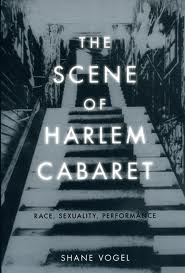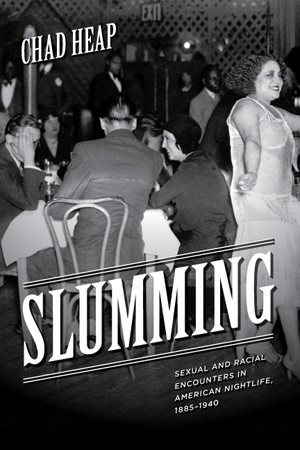 The Scene of Harlem Cabaret: Race, Sexuality, Performance
The Scene of Harlem Cabaret: Race, Sexuality, Performance
by Shane Vogel
University of Chicago Press. 257 pages, $22.
 Slumming: Sexual and Racial Encounters in American Nightlife, 1885-1940
Slumming: Sexual and Racial Encounters in American Nightlife, 1885-1940
by Chad Heap
University of Chicago Press. 432 pages, $35.
THE HARLEM RENAISSANCE: scene of scintillating literary salons, endless nightlife, after-hours parties, and a lot of drinking, if Richard Bruce Nugent’s writing is any indication, but it was also a sweatshop of intellectual productivity. The Renaissance writers’ often confessional work was at times treated disdainfully during their lifetimes, labeled the “cabaret school” by some literary critics of their day. Shane Vogel, an assistant professor of English at Indiana University, argues in his densely written The Scene of Harlem Cabaret that the Harlem Renaissance represented a radical break with the past practice of accommodating white racism through what he calls “the politics of normative racial uplift.” Instead they created “a subterranean literary tradition” that explored a new identity encompassing, among other elements, both the racial and sexual self.
In his examination of the history of the cabaret as performance space, Vogel points out that some Renaissance writers used the word cabareting (or cabaretting) to describe club-goers who started out at “respectable nightclubs” and ended up at low-down dives. Few photos of the well-known Harlem clubs survive, and those that Vogel chose to use tend to show an empty room before the customers arrived. Vogel uses this feature to explore the sightlines of these theaters, which were designed to let customers see not only the stage but also each other. The resulting “play of looks” (a phrase borrowed from Australian professor Gay McAuley) sets up a space for what we would call cruising and what Vogel calls “queer alternative performance.” The author finds that time as well as space could be marked by a queer consciousness, as in Langston Hughes’ “Café: 3 a.m.,” which describes the shifting rituals at late-night and after-hours clubs. The dilemma these folks faced, notes Vogel, was: “where does nightlife go when the sun comes up?”
White New Yorkers discovered that Harlem cabarets were the “in” places to go by means of a limited number of sources, notably the trend-setting Vanity Fair magazine, the vexingly titled 1926 book Nigger Heaven, by Carl Van Vechten, which went through fourteen printings in one year, and the musical Lulu Belle, written by Charles MacArthur and Edward Sheldon, which ran on Broadway for 461 performances in the 1920’s. However, many popular books, films, and songs of the era also contained scenes set in Harlem nightclubs or made reference to them.
Written in the language of postmodern-ese and coming with all the obligatory invocations of Foucault, Vogel’s book is another instance of “queer theory” run amok, and it may prove a hard slog for anyone untutored in its jargon and style of “discourse.” Don’t look for gossipy anecdotes or juicy newspaper quotations here.
For those, you can turn to Chad Heap’s Slumming, a book whose subject matter overlaps with Vogel’s but is written for a general readership. Heap, who teaches American studies at George Washington University, covers a broader period than Vogel and focuses on the sociology of the urban scene in which white, middle-class Americans would walk into an alien world of poor people in search of exotic entertainment, a soupçon of titillation, and perhaps a glow of self-righteousness. Heap writes mostly about New York and Chicago from the 1880’s to end of the Great Depression and provides detailed and unexpectedly engrossing insights into topics ranging from slumming excursions to descriptions of shows and performers, such as those at Chicago’s Dill Pickle Club (1915–1932), which produced its own masked ball.
While Slumming is not specifically about homosexuality, gay and lesbian life is woven through the book. In the words of the lesbian writer Mary Casal, whose autobiography The Stone Wall (1930) Heap quotes, “It was considered very smart to go slumming.” But she was horrified by the sights of the Bowery, where she saw “hundreds of male inverts.” In 1890’s America, Casal and her lover found no commonality with gay men. Forty years later, much had changed, as the lengthy chapter entitled “The Pansy and Lesbian Craze” shows. The word “pansy” was being used more frequently during the 1930’s, in tabloids and show-biz publications like Variety. While one may debate the point, Heaps makes a case that “the representation of pansies as closely linked to lesbians underscored their shared state of queerness.” By the time of the Depression, clubs in Times Square had added “queer entertainment” to boost revenues.
The slumming phenomenon still takes place in the 21st century, in the slums of Mumbai and the favelas of Rio, for instance, but as Heap notes in a very upbeat epilogue, slumming is “now poised to help both Americans and others to better understand the new global economy and transnational culture.”







